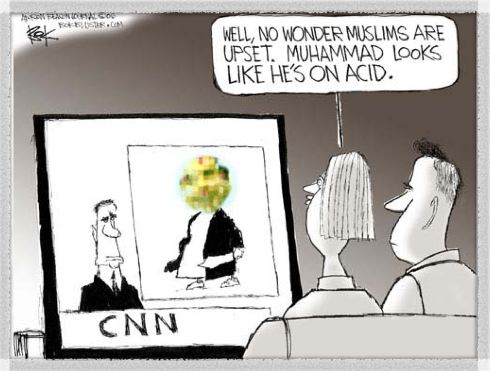Here's a cartoon the Akron Beacon-Journal apparently published a few days ago:

Here's the response:
Several Northeastern Ohio Muslims and community leaders met Friday to express their concerns about the controversial cartoons of the Prophet Muhammad that have ignited outrage and violence.
At issue are the caricatures published in the European press — work that many U.S. newspapers decided against publishing. The group also took issue with a cartoon inked by Beacon Journal editorial cartoonist Chip Bok.
Bok said he did not draw his cartoon with intentions of offending Muslims and has defended his right to free press.
But Muslims on Friday said Bok's cartoon was disrespectful and demeaning.
The level of hurt, they said, was deeper since it was in the local paper.
"It pained me to know that the Beacon Journal printed its own editorial cartoons that sought to challenge the beauty of our community by bringing hate into its pages," said Rabbi David Lipper, of Akron's Temple Israel. . . .
The editorial cartoon has prompted several letters in response. Also on Friday afternoon, there was a demonstration outside of the newspaper's East Exchange Street building.
At Friday's news conference at the Islamic Society of Akron & Kent in Cuyahoga Falls, the speakers were passionate.
A.R. Abdoulkarim, Amir of the Akron Masjid, applauded newspapers that decided against running the cartoons, but condemned those who did. The Beacon Journal, he said, was in a class of its own.
"They take the prize for being the most ill-intended, irresponsible property group," he said. "Allah curses and condemns them and every Muslim in this community should curse and condemn them."
Julia A. Shearson, director of Ohio's Council of American-Islamic Relations, said they want the Beacon Journal to apologize for running the "unethical" cartoon and want the paper to publish their letters to the editor.
After yesterday's press conference, Bok met with several leaders. The cartoonist said he drew the cartoon to take a shot at CNN for "distorting a distortion" and not at the prophet or Muslims. . . .
Still, Muslim leaders said Bok's cartoon was disrespectful because the prophet should not have been depicted in such a way. In fact, they said, there are no pictures or statues of Muhammad because he should not be confused with God. . . .
So I guess it's not just that we aren't supposed to draw pictures of Mohammed as terrorist, or of Mohammed at all; we aren't even supposed to draw pictures that are obviously not of Mohammed, and that are meant to mock the inability to draw pictures of Mohammed.
Well, I have to admit: The folks who are offended by this have a First Amendment right to be offended. They should feel entirely free to be offended.
The rest of us should feel entirely free, as a matter of civility as well as of law, to say: Your decision to be offended by this particular cartoon gives you no rights (again, as a matter of civility as well as of law) to tell us to stop printing it.
More on the underlying conceptual issue — the difficult but necessary distinction between (more or less) reasonable taking of offense and unreasonable taking of offense — later; I also hope then to talk in some measure about the distinction between this cartoon and others that I do think can reasonably be found to be offensive, and that probably shouldn't (as a matter of civility) have been published in the first instance, though it is proper to publish them now in order to explain the controversy. For now, it seems to me that this incident does plenty to illustrate the danger of the "it's wrong to publish any cartoons that offend people" attitude.
Many thanks to This Isn't Writing, It's Typing for the pointer.
All Related Posts (on one page) | Some Related Posts:
- Daily Illini Fires Editor Who Published the Mohammed Cartoons:
- President of Bar Association in Pakistan, Plus Major Pakistani Party, Supports Murder of Danish Cartoonists:
- The Twelve Mohammed Cartoons, in Detail:...
- Illinois Student Newspaper Editors Suspended for Running the Danish Cartoons:
- Reaction to the Cartoons Descends into Unintentional Self-Parody:
- A Second Look at the Second Extra Cartoon.--...
- U.S. State Department on the Cartoons Depicting Mohammed:
- Bush Cabinet Member Condemns Anti-Christian Blasphemy, and Points to Laws Restricting Incitement to Hateful Expressions:
- Suppressing Anti-Religious Speech -- an Emerging International Law Norm?